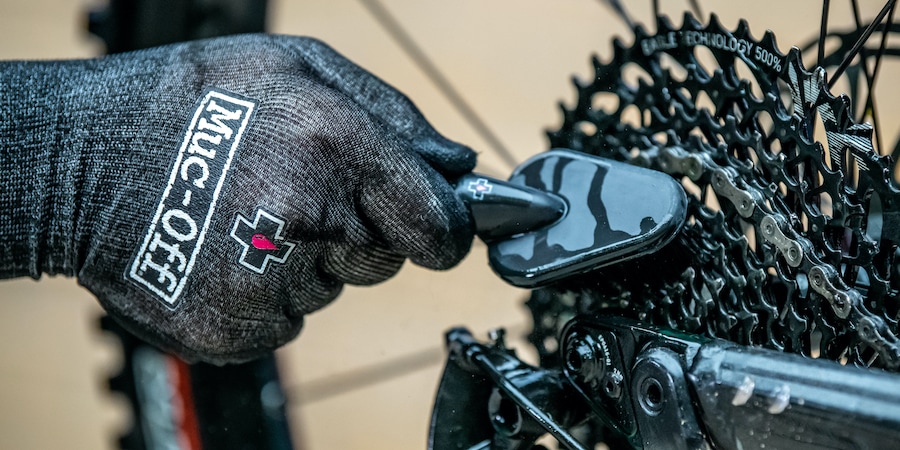Your bike is a collection of moving parts. When exposed to mud, grime and debris, these parts begin to deteriorate. A regular schedule of maintenance (monthly, weekly or more often depending on your type of riding) is important. If you spend a lot of time riding in wet, muddy conditions, or if you ride hard, fast and often, plan to clean your bike more frequently.
If you touch the chain with your finger and it comes away black and greasy, that's a sure sign that a clean and lube are needed. Another sign is hearing excessive amounts of chain noise when you're pedaling.
Keeping your bike parts properly cleaned and lubricated is crucial for good performance. Lubrication protects moving parts from excessive wear caused by friction, prevents them from "freezing up," and helps keep rust and corrosion at bay.
Be careful, though. Over-lubricating can lead to poor performance and component damage (excess lubricant will attract dirt and other abrasive particles). As a general rule, excess lube should always be carefully wiped away before the bicycle is ridden.
Tip: When lubricating a number of parts at once, remember the order in which you apply the lubricants. Wiping off excess lube in the same order will give the lubricants time to soak in.
Basic Bike-Cleaning Supplies
These simple items address most cleaning and lubing tasks:
Clean rags: Keep plenty of these on hand for grease, oil and wax-related tasks and for general cleaning and drying.
Brushes: Have several sizes and shapes to get into hard-to-reach places to remove the grime that rinsing alone can't get. Old toothbrushes work great.
Water: When used carefully, water can be a handy tool, but be careful here. Water, especially when coming from a high-pressure hose, can cause damage to sensitive bearing systems throughout your bike.
Soap / general cleaner: Use diluted dishwashing soap or preformulated bike wash cleaner for frame cleaning.
Degreaser: A bike-specific degreaser (avoid kerosene or turpentine) will clean up gummy parts like your bike chain. Choose a solvent that is easy on the environment (and you). Dispose of all solvents properly.
Chain lubricant: Properly lubricating your chain helps extend the life of your drivetrain. Always apply bicycle-specific lube oil to a clean chain. There are two types of lube: wet or dry.
- Wet lube is best to use when you'll be riding in wet conditions. It strongly adheres to the drivetrain and is less likely to rinse off in rain. That said, dirt and grit will also stick to it, so be sure to wipe off excess lube.
- Dry lube excels in a dry environment. Dirt and grit stick less to dry lube, but dry lube does rinse off easily if you find yourself riding in the rain.
Bike stand: This will allow you to position the bike at a comfortable height while you're working on it. It will also allow you to turn the pedals or remove the wheels so you can clean all the moving and hard-to-reach parts.
Shop Bike Lubricants and Cleaners
What to Clean and How
Most dirty bike components can be cleaned by wiping them carefully with a damp or dry rag. Other components require occasional brushing, scrubbing and relubrication.

Washing your bike with a high-pressure hose can cause damage to sensitive bearing systems throughout your bike. So, when washing off muck and soap, do so carefully.
Cleaning your bike consists of four main steps:
- Wash the bike frame
- Clean and lubricate the chain
- Lubricate the brake and derailleur levers
- Lubricate the brake/derailleur cables and brake/derailleur assemblies
Your drivetrain (front chain rings, rear cassette, rear derailleur and chain) deserves the most frequent attention, so watch our video for some useful instruction.
Video: Cleaning Your Drivetrain
Wash the bike frame: Use a bucket of warm soapy water and a brush to gently scrub off dirt and grime. Work from the top down, cleaning the handlebars, headset, top tube, seat post, seatstays, front fork and brakes. If you have disc brakes, try to keep soap away from the rotors and brake pads. You can use a specific rotor cleaner or rubbing alcohol to clean the rotors. Finish by scrubbing the chainstays, chain rings, cranks and cogs. Now use a bucket of clean water and brush to rinse all of the parts in the same order you cleaned them. Follow that up by drying the bike thoroughly with a few clean, dry rags.
Clean and lubricate the chain: Your chain is your bike's most at risk lubricated part. Clean and lube it frequently to slow the rate of chain wear.

To clean chains that don't have too much built-up grime, simply use a rag and degreaser. For really dirty chains, you may want to use a chain-cleaning device, which is more thorough and a lot less messy.
After the degreaser has dried, apply drops of lube slowly onto to the chain, getting some on each link. Let the lube dry, then wipe off any excess lubricant so it doesn't attract more dirt.
In general, lubricate your chain whenever it squeaks or appears dry. Lubing after wet rides will help keep your chain from rusting.
Lubricate the brake and derailleur levers: After washing your bike, you can also apply a drop or two of dry lube to the lever pivots and the barrel adjusters to keep them functioning properly. (This step can be done less often than lubing the rest of the drivetrain.)
Lubricate the brake and derailleur cables: Check them frequently (especially in wet conditions) and relubricate occasionally with dry lube so that they can effectively translate your commands to the component groups.
Lubricate the brake and derailleur assemblies: These consist of a number of small moving parts. Keep an eye on their arms, wheels and pulleys so they don't bind up or become rigid. Apply dry lube to the pivot points. Be careful to keep lubricant away from your brake pads.
